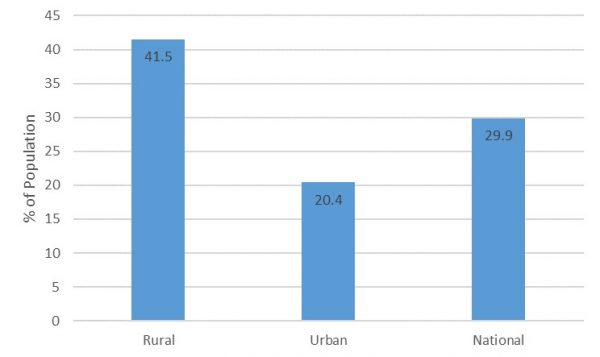The Fiji Bureau of Statistics (FBS) released its preliminary report on the 2019-2020 Household Income and Expenditure Survey (HIES) on 8 February. The survey is based on a representative sample of 6,000 households and was conducted from February 2019 to February 2020. Thus the 2019-2020 HIES report provides a snapshot of poverty prior to the impact of COVID-19.
The HIES is a national and regularly conducted survey and is the main source of data on poverty in Fiji. Previous surveys were conducted in 1977, 1990-1991, 2002-2003, 2008-2009 and 2013-2014. Poverty analyses based on the earlier surveys can be found in this 2008 paper by Waden Narsey.
Using a national basic needs poverty line (BNPL) of $2,179.39 per adult equivalent (PAE) per year (or $8717.56 per year for a household with 4 adult equivalent), the number of individuals living in poverty is estimated from the 2019-2020 HIES to be 29.9%. This would equate to 258,053 of the total population, or 45,724 households (22.9% of all households) living in poverty during the survey period. Out of the four divisions, Eastern division recorded the highest poverty rates with 42.7%. The rates of poverty in Northern and Western divisions are estimated to be around 35.2% and 32.4% respectively.
Of the total population, the incidence of poverty in rural areas is twice the rate of poverty in urban areas (Figure 1). Out of all the people who have been defined as living in poverty, around 62% live in rural areas.
Figure 1: Percent of Fijian population in poverty 2019-2020 
The latest poverty figures show that poverty reduction had stagnated in Fiji, even before the impact of COVID-19. The poverty rate in fact increased from 28.1% in 2013-2014 to 29.9% in 2019-2020. It is beyond doubt that Fiji’s economic performance during the last six years has been unable to match its ability to lift more people out of poverty. Economic growth is a central strategy for poverty reduction, but it has been constantly difficult to sustain the higher growth rates required to make a significant dent on poverty. In a recent article, I argued that low growth had become the “new normal” for Fiji.
At this rate, it is becoming increasingly clear that Fiji will not be able to meet its 2030 Sustainable Development Goals poverty reduction target (which requires a halving of poverty in all its dimensions according to national definitions).
Poverty is a multifaceted problem with a variety of causes. Previous research I have undertaken has shown that a combination of macroeconomic, household and community characteristics can play a part in contributing to the incidence of poverty in Fiji. In particular, this and previous surveys continue to show that there are differences in household incomes and consumption between rural and urban areas throughout Fiji that need to addressed.
Since this most recent HIES, the COVID-19 pandemic has exacerbated the tough conditions for an economy that was already slowing down in 2019. The impacts of the pandemic and border closures have led to a stark decline in economic growth, disproportionately affecting vulnerable households and communities. As the pandemic’s negative impact is expected to continue through to 2021, the poverty rate will worsen and is expected to rise to well above 30%. Moreover, due to Tropical Cyclone Yasa and recent flooding in Vanua Levu, growth in the agriculture sector is forecast to weaken, contributing to an increase in food insecurity and aggravating poverty.
The 2019-20 HIES is not good news for Fiji. Reversing the increase in poverty associated with COVID-19 will be difficult enough. Major policy and institutional reforms will be needed to put poverty on a downward trend.


The HIES Report is out and poverty remains.It now appears to be systemic but, not only in Fiji. We must keep on the development radar the fact of unfinished business with the MDGs before the SDGs were introduced. HIV still exists. There is also the confounding rise in NCD’s. Poverty prevails and the ‘Youh buldge’ with high rates of unemployment persists. There is also as per the figures the rising tide of population ageing, those 65 and over, to almost nine percent. Needless to say efforts in Fiji, and other developing countries, in achieving any of the SDG’s are now negatively affected , and will be fraught with the debt-ridden effects of Covid 19 and the enduring impact of of Climate Change especially on the key economic sectors. The recent ( August 2021) IPCC Report casts a troubling shadow of climate variability on the development agenda of, especially, Small Island Development States( SIDS) including Fiji. Robust policies to stimulate the economy while protecting the vulnerable with appropriate and relevant social protection regimes will be the way forward. What should be the development thinking be. Are we still in search of the ‘rising tide’ of affluence that will ‘lift all boats ? ‘
In light of the crisis that Fiji is currently going through, it is evident that we will not be able to achieve the SDG goals in the year 2030. As such fiscal policy tools are most resorted to in order to tackle poverty and inequalities. As mentioned above that we are in dire need of reforms, would you be able to suggest some reforms that are much needed, monetary or fiscal?
Yes, achieving several SDG targets by 2030 will be extremely difficult, if not unattainable. Sustained economic performance remains the best strategy to improve economic and social and outcomes. Apart from fiscal and monetary policies, other specific policies (labour market, trade, environment, agriculture and manufacturing) will be key towards maintaining inclusive and broad based growth.
Thank you Dr Neelesh for a thorough and simple analysis on the 2019-20 HIES report. There is a change in methodology in this HIES compared to the previous. Past reports were on the income approach and this report they change to the consumption approach. Can these be the cause of slight increase in poverty rate? If they would have remained on the income approach, my guess is the poverty rate would have reduced even further. Please your comments would be appreciated. Vinaka
Yes, the there is a change in methodology – the change, however, can not be associated with the increase in poverty rate.
Thank you Dr. Goundar for the interesting read. Is there any analysis done on the sectors that are suffering the most? It would be good to see the impact i.e. pre-covid vs post covid.
We’ll need another survey to clearly figure out the magnitude of the impact on specific sectors post-COVID.
Thanks for this interesting article! Is the basic needs poverty line (BNPL) referring to Fiji Dollar or US Dollar or any other unit?
Fiji dollar